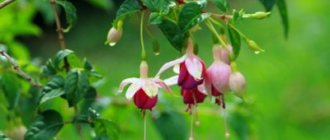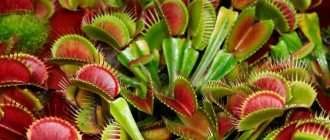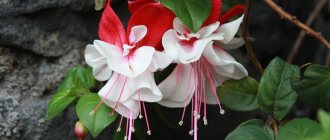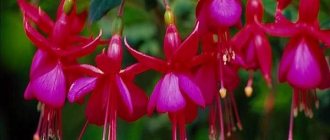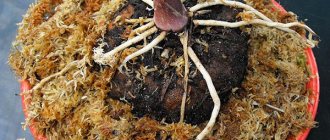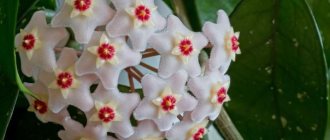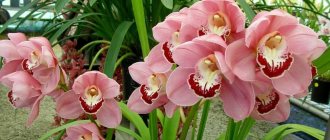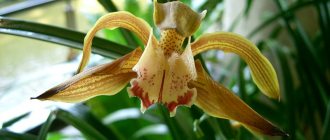Fuchsia has made flower growers fall in love with its elegant appearance and long flowering period. This variegated plant is easy to care for, grows vigorously and reproduces easily.
To make a choice without regrets, you need to decide which species are suitable for which planting conditions.
It doesn’t matter whether you grow a crop in a flowerbed in the garden or in a pot, you need to choose the right variety. When giving preference to a particular variety, take into account not only the characteristics and timing of flowering, but also resistance to poor external conditions.
First of all, decide on the color palette, then decide on the shape of the bush.
Fuchsia grows as a hanging plant, shrub or low tree.
Description of fuchsia
Depending on the species, the plant is a tree or a bush. The flexible branches are covered with oval-lanceolate opposite leaves of a green or slightly reddish hue. They do not exceed 5 cm, pointed at the ends and along the edge with teeth or smooth.
The flowers have an elongated tubular calyx and long stamens. After them, edible fruits appear.
Types and varieties of fuchsia
Fuchsias can be grown as ampelous, bush plants, or formed into a pyramidal or standard tree.
Varieties can bloom in different seasons of the year. As a rule, almost all varieties have edible fruits (berries), but in room conditions they are difficult to ripen; you must wait until they turn black before using them for food.
Bush
| View | Description | Leaves | Flowers, their blooming period |
| Three-leaved | Size 60 cm. It grows in breadth, so it is good to place it in a hanging container. Large berries (5 cm). | Ovoid. 8 cm long and red in color, the back is greener and the underside is brown. | A large number of bell-shaped species, connected by fiery sepals into inflorescences. May - October. |
| Waist | Height - 50 cm. The fruits have a delicate taste. | Velvety dark green with hints of burgundy. | Bright orange medium. Spring - autumn. It can be extended throughout the winter by providing (temperature +25 °C) and lighting for at least 12 hours. |
| Magellan | Reaches 3 m. Sweet, tart. | Small, pointed (up to 4 cm). | Tubular from red to white colors. Spring - autumn. |
| Sparkling | Size 2 m. The fruits are edible. | Large serrated. | Scarlet. Summer. |
| Shiny (shining) | Height from 40 cm to 1 m. The berry is edible, rich in vitamins. | Large oval, green with a purple tint. | Raspberry-purple. April - November. |
| Graceful | Up to 1 m. Similar to Magellan. | Elongated oval (up to 5 cm). | Voluminous, bright pink, maybe with a purple center, sitting on small stalks. Spring - late autumn. |
| Splendence | Multileaf. The fruits are larger than other species (5 cm) with a tart lemon flavor. | Simple oval-lanceolate. | It looks like a long red pipe with light green petals at the ends. Whole year. |
| Bolivian | Beautiful, spectacular. Grows up to 1 m. The berries have a slight narcotic effect. Light lemon and pepper flavor. | Large velvety. | Collected in brushes, red and white, large. March, April. |
| Bright red | Reaches 1-1.2 m. The fruits are difficult to grow at home. | Lanceolate (3-5 cm). | The tubular sepals are red, the petals are purple. Beginning of April - end of October. |
| Thin | Grows up to 3 m. Narrow flowing reddish branches. Can be trimmed to guide its growth in width. | With a burgundy tint. | Numerous violet-purple. Collected in brushes. July - September. |
| Thyroid | Height - 3 m. The fruit is rich in vitamins. | Oblong-oval up to 7 cm. | White, red with a purple core. Mid-summer - early autumn. |
| Recumbent | 40 cm-1 m. Thin creeping shoots. The difference is diversity. Light red berry. | Round or heart-shaped. | Yellow, growing upward. April - November. |
Other beautiful varieties with double and semi-double flowers:
- Alisson Bell (violet-red);
- Anabelle (white);
- Ballerina (scarlet in the middle of a light pink skirt);
- Henriette Ernst (sepals - deep pink, petals - soft lilac).
Ampelous types:
- Blue angel (terry, white with lilac);
- Hollies Beauty (purple-blue);
- Imperial Crown (scarlet);
- Prince of Peace (white with red center).
Growing and caring for fuchsia at home
The flower goes through an active growing season in April - August. December - January is his rest period.
| Factor | Spring | Summer | Autumn | Winter |
| Location | Windows on the west and east sides (lots of diffused light). | |||
| Lighting | Can be placed in open space. | At least 12 hours. | Illuminated when there is not enough sun. | |
| Temperature | +18…+24 °C. | +5…+10 °C. | ||
| Humidity | Spray with warm filtered water every day in the evening and morning. | 1 time in 3 days. | No need. | |
| Watering | When the top layer of soil dries out. | Reduce, but do not allow the soil to dry out completely. | No more than 2 times a month. | |
| Top dressing | 2 times a month with mineral fertilizers for flowering plants. | Do not use. | ||
Rules for outdoor care
Caring for garden fuchsia is not too difficult, but it is recommended to pay attention to compliance with the irrigation and fertilizing regime. Lush, long-lasting and maximally abundant flowering will be facilitated by frequent spraying and sufficiently abundant watering, timely high-quality fertilizing
Proper irrigation measures are the most important part of growing fuchsia. The amount and frequency of watering directly depend on a large number of factors, including varietal characteristics, stage of growth and development, location of the ornamental crop, soil composition on the site and weather conditions
High temperature conditions cause intense evaporation, so fuchsia foliage must be sprayed periodically.
However, excessive soil moisture in a flower garden can displace oxygen from the soil and cause rotting of the root system, as well as the subsequent death of the ornamental crop. If the soil gets too dry, the plant may lose all its foliage. Drooping leaves serve as a signal for watering. However, there is absolutely no need to water the plant in late autumn or winter. After watering, the soil around the plant is shallowly loosened and weeds are removed.
When buds appear on fuchsia bushes and during flowering, the ornamental crop must be fed. For this purpose, it is recommended to water weekly with special liquid fertilizers intended for feeding flowering plants.
Fuchsia propagation rules
There are two methods for obtaining new fuchsias: seed and cuttings.
Seeds
This is a rather labor-intensive process, which, as a rule, does not preserve the individuality of the mother flower. Seeds are sown in early spring:
- Since they are very small, they are mixed with sand and scattered on the surface of the soil.
- Sprinkle with a small amount of substrate.
- Cover with film or glass.
- Maintain temperature +15…+18 °C. Water into a tray.
- Sprouts appear within a month.
- When two sheets are formed, they are picked.
Vegetative
Old or young shoots (about 10 cm) are used as cuttings, which are cut at the end of winter:
- The lower leaves are removed. The cuttings are placed in a glass with water, liquid substrate or sand.
- Create a mini-greenhouse using a plastic container or bag.
- After 2 weeks, when roots appear, the cuttings are replanted.
How to plant fuchsia sprouts
The sprouts are planted in small containers, no more than 9 cm in diameter. Drainage is required. The pot is completely filled with earth so that there are no voids. To do this, it is shaken and tapped, but not compacted by hand; the soil must be porous.
Transplantation is performed in the spring once a year. An adult bush is shortened by 1/3, the roots are trimmed (excluding hanging varieties).
The substrate used is slightly acidic, there are several options:
- sand, peat, sheet soil (1:2:3);
- sand, greenhouse, clay-turf soil, peat chips (1: 2: 3: 0.2);
- ready-made mixture for flowering plants.
Further step by step process:
- A ceramic pot is used to protect the root system from the summer heat, about 4 cm larger than the previous one.
- Pour drainage onto 1/5 of the new container (expanded clay, pebbles) to protect the plant from rotting.
- Sprinkle with substrate.
- Using the transfer method, the fuchsia is removed from the old container, without shaking off the soil, and placed in a new one. The voids are filled.
- Spray and water until moisture appears in the stand. After a while, excess liquid is removed.
- No feeding for 30 days.
- After another 60 days, flowering is expected.
Landing
You need to plant the flower in small ceramic pots. It is better to choose this material because it maintains the required temperature and humidity level longer. In order for the shrub to bloom beautifully, it is necessary to plant cuttings of ampelous varieties evenly in 3-5 pieces.
When planting bush forms, you need to place one crop in each small-diameter pot. This is necessary so that the root system can envelop the entire earthen ball over the entire season. If you choose a large container, the roots will rot, and the small ones will wrap.
Drainage should be placed at the bottom of the pot. Expanded clay is ideal for this purpose. In moist soil there should be growing roots. In this case, you should straighten the roots and sprinkle with loose soil and water. You can also mulch the soil to retain moisture as long as possible. It is better to use peat.
Methods for pruning fuchsia
Fuchsia is pinched to stimulate good flowering, the appearance of a large number of young shoots, as well as to form the plant into a ball, bush, or bonsai tree.
It is pruned twice a year: after flowering in October and during the dormant period in January.
Autumn
Remove stems that have bloomed. Dormant buds are left 2 cm below the cut.
Winter
Thin shoots are removed, woody old ones are pruned, since flowers are formed mainly on young shoots.
Bonsai
When forming a small tree, one shoot or several are left that can be twisted. The top is pinched to create a lush crown.
Bush
If you shorten the flower to the very stump, it will remain dormant longer, bloom late, but at the same time it will produce many young shoots and the plant will take on the appearance of an extensive shrub.
Preparing for winter
If an ornamental crop is grown in flower pots or cache-pots, which are taken outside only in summer to decorate the garden area, then the optimal option for overwintering the plant will be almost any sufficiently bright and relatively warm room with a temperature range of 5-15°C. Experienced gardeners place fuchsia in pots before the onset of significant cold weather on glazed balconies or heated loggias.
At the beginning of September, nitrogen-containing fertilizers are completely excluded from feeding. Instead of fertilizing, phosphorus-potassium fertilizers are given at each irrigation event a couple of times a week. Watering is also reduced. Even in the central zone of our country, fuchsias most often freeze out in the winter, so it is recommended to dig up ornamental garden plants from the ground in the autumn and replant them in flower pots. Garden fuchsia must have time to take root well before it is placed indoors for the winter.
It is important to remember that for the “dark” wintering of fuchsia, it is necessary to prune all immature and non-lignified shoots, preserving the main branches and obligatory removal of all remaining green mass. For a “light” wintering, pruning needs to be done more gently, so green shoots can be left
Problems when growing fuchsia, diseases and pests
With insufficient care and non-compliance with the rules of agricultural technology, the plant suffers from various diseases.
| Manifestation | Cause | Corrective measures |
| Curling of leaves. | Fever. | They shade. |
| Falling leaves. | Lack of lighting, low air humidity. | Spray in hot weather. |
| Dropping buds. | Excessive or incomplete watering, lack of light and nutrition. Plant disturbance during the growing season. | Provide the correct watering regime. Do not disturb when buds are pouring. Feed correctly. |
| Flowering is short and small. | The rest period took place in too warm conditions. | Provides coolness during winter. |
| Browning of foliage. | Overmoistening at low temperatures. | Reduce watering. |
| Root rot. | Excessive watering and spraying, stagnation in the pan. | Treated with fungicides (Fitosporin). Reduce watering |
| Covering leaves with white cobwebs. | Spider mite. | Spray with acaricide (Fitoverm) 3-4 times every 7 days. |
| The appearance of white insects. | Whitefly. | Insecticides are used (Aktara, Fufanon). 6-7 times every 3 days. |
Diseases
- Powdery spots indicate powdery mildew, which is usually caused by excess moisture; Fundazol and Topaz are used for healing.
- Yellowness and dryness are signs of chlorosis, usually from excess water and too cold a climate. Watering with a slightly pink manganese solution will relieve the disease.
- Brown spots indicate a dangerous infection. It's most likely rust. All painful fragments are removed and sprayed with Bordeaux solution once every ten days (three times a day).
- Lethargy of leaf blades causes insufficient nutrition and illumination.
- Whiteflies, spider mites and aphids can also be a nuisance. The drugs Actellik and Angara help.
- A hot shower once every seven days is a good preventive measure against ticks, and watering once every 6 months with Aktara protects against other parasites.
